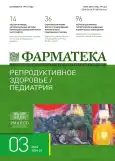The role of an infectious agent in development of fever in parturient women during epidural analgesia: data from a prospective cohort study
- Authors: Podzolkova N.M.1,2, Denisova Y.V.1,3, Gerasimov A.N.4, Denisova Т.V.1,5
-
Affiliations:
- Russian Medical Academy of Continuous Professional Education
- S.P. Botkin City Clinical Hospital of the Moscow Healthcare Department
- Pletnev City Clinical Hospital of the Moscow Healthcare Department
- Central Research Institute of Epidemiology
- Inozemtsev City Clinical Hospital of the Moscow Healthcare Department
- Issue: Vol 31, No 3 (2024)
- Pages: 59-65
- Section: Original articles
- URL: https://journals.rcsi.science/2073-4034/article/view/262435
- DOI: https://doi.org/10.18565/pharmateca.2024.3.59-65
- ID: 262435
Cite item
Abstract
Background. The relevance of this study is dictated by the widespread use of epidural analgesia (EA) during labor, the adverse effects of which must be taken into account.
Objective. Evaluation of the role of the infectious agent in the development of fever in parturient women who underwent EA according to indications.
Methods. The prospective cohort study included 150 patients whose childbirths occurred in the Maternity Hospital No. 2 of the Inozemtsev City Clinical Hospital (Moscow) in the period from October 1, 2022 to May 4, 2023. The main group consisted of 100 parturient women who were anesthetized by EA for pain syndrome (7 or more points on the visual analogue scale), the comparison group included 50 patients whose childbirths were carried out in the absence of neuraxial anesthesia. 49 patients with EA-assisted childbirth and T<37.5°C were included in subgroup A, 51 patients with T≥37.5°C – subgroup B. In these subgroups, a comparative analysis of the course of childbirth and type of delivery, serum levels of pro-inflammatory cytokine interleukin-6 (IL-6), results of histological and microbiological studies of placentas and cultures for the microflora of vaginal discharge, one-factor correlation analysis to clarify the reliability of the identified relationships were performed.
Results. The analysis revealed a statistically significant association of using of EA with leukocyte infiltration of the placentas, which was detected with this method of analgesia 3 times more often than in its absence: 33 (33%) and 6 (12%) out of 100 patients, respectively ( p=0.004). There were 17 cases of chorioamnionitis (CA) reported in the EA group. According to the further analysis of subgroups, it was noted that leukocyte infiltration of placentas in patients with T≥37.5°C was recorded 2.5 times more often than in women with normothermia: 23 (43%) of 54 and 16 (17%) of 96 patients (p=0.001). Leukocyte infiltration against the background of EA was associated not only with an increase in the body temperature of parturient women, but also with an increase in the most active pro-inflammatory pyrogenic cytokine IL-6 (p=0.005). The frequency of detection of opportunistic microflora in placental tissue in both subgroups was comparable, indicating that there was no reliable relationship between the bacterial nature of CA and epidural anesthesia.
Conclusion. Thus, the obtained relationships confirmed the dominant role of the non-infectious inflammatory process in the pathogenesis of fever against the background of EA. A more detailed understanding of the pathophysiological mechanisms of the condition under study will allow to develop the most effective measures for the prevention and treatment of EA-associated fever, and improve perinatal outcomes.
Full Text
##article.viewOnOriginalSite##About the authors
N. M. Podzolkova
Russian Medical Academy of Continuous Professional Education; S.P. Botkin City Clinical Hospital of the Moscow Healthcare Department
Email: yuliya.sheveleva.97@mail.ru
ORCID iD: 0000-0001-9183-7030
Russian Federation, Moscow; Moscow
Yuliya V. Denisova
Russian Medical Academy of Continuous Professional Education; Pletnev City Clinical Hospital of the Moscow Healthcare Department
Author for correspondence.
Email: yuliya.sheveleva.97@mail.ru
ORCID iD: 0000-0003-1753-0537
Teaching Assistant at the Department of Obstetrics and Gynecology, Russian Medical Academy of Continuous Professional Education; Obstetrician-Gynecologist, Pletnev City Clinical Hospital of the Moscow Healthcare Department
Russian Federation, Moscow; MoscowA. N. Gerasimov
Central Research Institute of Epidemiology
Email: yuliya.sheveleva.97@mail.ru
ORCID iD: 0000-0003-4549-7172
Russian Federation, Moscow
Т. V. Denisova
Russian Medical Academy of Continuous Professional Education; Inozemtsev City Clinical Hospital of the Moscow Healthcare Department
Email: yuliya.sheveleva.97@mail.ru
ORCID iD: 0000-0002-6549-107X
Russian Federation, Moscow; Moscow
References
- Goetzl L. Epidural Fever in Obstetric Patients: It’s a Hot Topic. Anesth Analg. 2014;118(3):494–95. doi: 10.1213/ANE.0000000000000112.
- Sultan P., David A.L., Fernando R., Ackland G.L. Inflammation and epidural-related maternal fever: proposed mechanisms. Anesth Analg. 2016;122:1546–53. doi: 10.1213/ANE.0000000000001195.
- Riley L.E., Celi A.C., Onderdonk A.B., et al. Association of epidural-related fever and noninfectious inflammation in term labor. Obstet Gynecol. 2011;117:588–95. doi: 10.1097/aog.0b013e31820b0503.
- Roberts D.J., Celi A.C., Riley L.E., et al. Acute histologic chorioamnionitis at term: nearly always noninfectious. PLoS One. 2012;7:e31819. doi: 10.1371/journal.pone.0031819.
- Sharma S.K., Rogers B.B., Alexander J.M., et al. A randomized trial of the effects of antibiotic prophylaxis on epidural-related fever in labor. Anesth Analg. 2014;118:604–10. doi: 10.1213/ANE.0b013e3182a5d539.
- Герасимов А.Н., Морозова Н.И. Параметрические и непараметрические методы в медицинской статистике. Эпидемиология и вакцинопрофилактика. 2015;5(84):6–12. [Gerasimov A.N., Morozova N.I. Parametric and non-parametric methods in medical statistics. Epidemiologiya i vaktsinoprofilaktika=Rus J Epidemiol Vaccin. 2015;5(84):6–12. (In Russ.)].
- Vallejo M.C., Kaul B., Adler L.J., et al. Chorioamnionitis, not epidural analgesia, is associated with maternal fever during labour. Can J Anesth. 2001;48:1122–26.
- Schminkey D.L., Groer M. Imitating a stress response: a new hypothesis about the innate immune system’s role in pregnancy. Med Hypotheses. 2014;82:721–29. doi: 10.1016/j.mehy.2014.03.013.
- Laham N., Brennecke S.P., Rice G.E. Interleukin-8 release from human gestational tissue explants: the effects of lipopolysaccharide and cytokines. Biol Reprod.1997;57:616–20. doi: 10.1095/biolreprod57.3.616.
- Goetzl L., Rivers J., Evans T., et al. Prophylactic acetaminophen does not prevent epidural fever in nulliparous women: a double-blind placebo-controlled trial. Perinatol. 2004;24:471–75. doi: 10.1038/sj.jp.7211128.
- Goetzl L., Evans T., Rivers J., et al. Elevated maternal and fetal serum interleukin-6 levels are associated with epidural fever. Am J Obstet Gynecol. 2002;187:834–38. doi: 10.1067/mob.2002.127135.
- Nelson G., Wilde G.J., Spiller D.G., et al. NF-kappaB signalling is inhibited by glucocorticoid receptor and STAT6 via distinct mechanisms. J Cell Sci. 2003;116:2495–503. doi: 10.1242/jcs.00461.
Supplementary files









